As Fudo Myo-o, ;Acala is considered one of the Thirteen Buddhas in Japan. Fudo myo-o, meaning "Immovable
Wisdom King", is the patron deity of the Yamabushi. He usually holds a sword and a lariat, is clad in rags, has one fang pointing
up and another pointing down, and a braid on one side of his head. His statues are generally placed near waterfalls and deep
in the mountains and in caves.
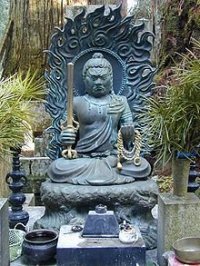
Shugendo (ä¿®) is an ancient Japanese religion in which enlightenment or oneness with kami is obtained
through the study of the relationship between Man and Nature. Shugendo literally means "the path of training and testing."
It centers on an ascetic, mountain-dwelling lifestyle and incorporates teachings from Koshint?, Buddhism and other eastern
philosophies including folk animism. Shugendo practitioners are the most direct lineage descendants of the ancient hijiri
of the eight and ninth centuries The focus or goal of shugend? is the development of spiritual experience and power.
Fudo-Myo-o
Shugendo will push you along a new road of existance, you will develop an new perception of life. And come to understand your
mind and body and how it fits into a natural flow and rhythm with the universe.
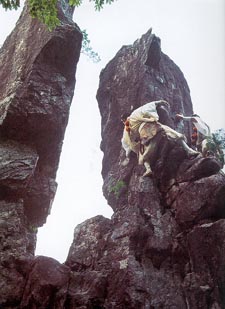
To turn around the Rock of Equality Test of free-climbing during Omine Pilgrimage
Fudoshin
A spirit of unshakable calm and determination,
courage without
recklessness,
rooted stability in both mental and physical realms.
Like a willow tree,
powerful roots deep in the
ground
and a soft, yielding resistance against
the winds that blow through it.
Fudo-Myo-o Shugendo is a mixture
of Martial arts, Yoga, Meditation, Self-Defence,Health and Fitness, Zen Buddism and Taoism.
Fudo-Myo-o Shugendo is
not an art or something that you can see, it is a way to live you life. You should feel that you are connected to something,
only then will you realize how much potential you have inside of you.
Bruce Lee had some great ideas about the natural
order of things and how they had a certain progression thoughout life. For example these are some of his Quotes.....
"Don't
think; feel. It's like a finger pointing away to the moon. Don't concentrate on the finger, or you will miss all the heavenly
glory." Bruce Lee in Enter The Dragon (1974)
"Be like water making its way through cracks. Do not be assertive,
but adjust to the object, and you shall find a way round or through it. If nothing within you stays rigid, outward things
will disclose themselves.
Empty your mind, be formless. Shapeless, like water. If you put water into a cup, it becomes
the cup. You put water into a bottle and it becomes the bottle. You put it in a teapot it becomes the teapot. Now, water can
flow or it can crash. Be water my friend".Bruce Lee
Question: What are your thoughts when facing an opponent?
Bruce: There is no opponent.
Question: Why is that?
Bruce:
Because the word ''I'' does not exist.
A good fight should be like a small play...but played seriously. When the opponent
expands, I contract. When he contracts, I expand. And when there is an opportunity... l do not hit...it hits all by itself.
"The highest technique is to have no technique. My technique is a result of your technique; my movement is a result
of your movement".
Bruce Lee.
"A fight is not won by one punch or kick. Either learn to endure or hire a bodyguard".
Bruce Lee
"Forget about winning and losing; forget about pride and pain. Let your opponent graze your skin and you
smash into his flesh; let him smash into your flesh and you fracture his bones; let him fracture your bones and you take his
life. Do not be concerned with escaping safely - lay your life before him". Bruce Lee
Has you can see from these passages
Bruce is using Zanshin, Mushin, Shoshin, and Fudoshin......to develope his art of JKD.
Fudo-Myo-o Shugendo will open
you up like a closed book and will guide you into what ever you wish to acheive in your life.
The
main principles of this style are:
Zanshin is a term used
in the Japanese martial arts. It refers to a state of awareness – of relaxed alertness. The literal translation of zanshin
is "remaining mind".
Mushin Chinese wúxÄ«n; English translation "no-mindedness"
is a mental state into which very highly trained martial artists are said to enter during combat. The term is shortened from
mushin no shin, a Zen expression meaning mind of no mind. That is, a mind not fixed or occupied by thought or emotion and
thus open to everything
Shoshin also pronounced nyuanshin is a concept
in Zen Buddhism meaning Beginner's Mind. It refers to having an attitude of openness, eagerness, and lack of preconceptions
when studying a subject, even when studying at an advanced level, just as a beginner in that subject would.
Fudoshin is a state of equanimity or imperturbability (literally and metaphorically, "immovable
heart"or "unmoving heart"– a philosophical/mental dimension to a (usually Japanese) martial art which contributes to
the effectiveness of the advanced practitioner.
Shin Gi Tai means Spirit , Technique, Body. The three inseparable
entities which create the whole martial artists. If one element is de-emphasised in the least,the true martial artist becomes
unbalanced.
Shin Gyo Action of the heart. Do things through the heart.
Hei Jo Shin Normal state of mind. Maintain
one's state of mind or composure without being affected by the environment.
Hei Jo Shin no Michi The way of the composed mind. Think all the time about what you are practicing before and after.
Rei
Gi Shin Chi Jin Courtesy, Obligation, Belief, Knowledge, Virtue.
These are called Go Jo, or the Five Ordinaries (Confucian)
and are considered the begining of Budo (budo no hajime). Without these five Confucian ethics the martial arts devolve into
brutish brawling.
I wish to develop a new marial art which combines philosophy, spirituality, Yoga, meditation, fitness and a religious aspect
which can help with everyday life.
These are the main priciples to learn
The
Zanshin is a term used in the Japanese martial arts. It refers to a state of awareness – of relaxed alertness. The literal
translation of zanshin is "remaining mind".
In kyudo, zanshin means the body posture after the loosing of an arrow; the posture
is intended to reflect the higher meaning of zanshin, which is a mental aspect maintained before, during, and
after an action.
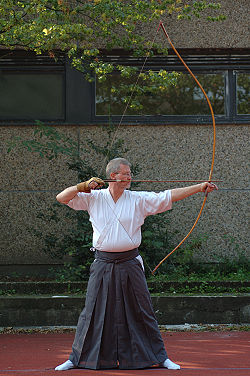
In karate, zanshin is the state of total awareness. It means being aware of one's surroundings and enemies, and also
being prepared to react.
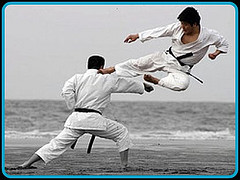
In the context of kendo, zanshin is the continued state of spirit,
mental alertness and physical readiness to meet the situation (such as an opposing attack) that must be maintained when one
returns to kamae after attacking. It is one of the essential elements that define a good attack.
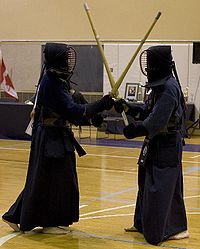
During the practice of aikido, the usual method of practicing zanshin is to focus on
the just-thrown uke, or opponent, while holding kamae and maintaining awareness in case there are additional attacks or attackers.
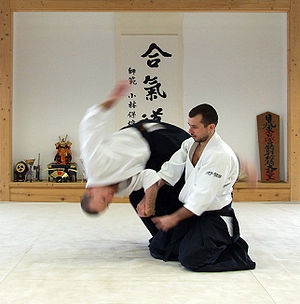
Mushin Chinese wúxÄ«n; English translation ("no-mindedness") is a mental state into
which very highly trained martial artists are said to enter during combat. The term is shortened from mushin no shin , a Zen
expression meaning mind of no mind. That is, a mind not fixed or occupied by thought or emotion and thus open to everything.
Mushin is achieved when a person feels no anger, fear or ego during combat. There is an absence of discursive thought and judgment, so the person is totally free to act and react towards
an opponent without hesitation. At this point, a person relies not on what they think should be the next move, but
what is felt intuitively. It is not a state of relaxed, near-sleepfulness, however. The mind could be said to be working at a very high speed, but
with no intentions, plans or direction.
A martial artist would likely have to train for many years to be capable of mushin. This allows time for combinations of
movements and exchanges of techniques to be practised repetitively many thousands of times, until they can be performed spontaneously,
without conscious thought. If he is capable of truly listening to his teacher, however, he could attain this level in only
a few years. Some masters believe that mushin is the state where a person finally understands the uselessness of techniques
and becomes truly free to move. In fact, that person will no longer even consider themselves as "fighters" but merely living
beings moving through space
The legendary Zen master Takuan Soho said:
The mind must always be in the state of 'flowing,' for when it stops anywhere that means the flow is interrupted and it
is this interruption that is injurious to the well-being of the mind. In the case of the swordsman, it means death. When the
swordsman stands against his opponent, he is not to think of the opponent, nor of himself, nor of his enemy's sword movements.
He just stands there with his sword which, forgetful of all technique, is ready only to follow the dictates of the subconscious.
The man has effaced himself as the wielder of the sword. When he strikes, it is not the man but the sword in the hand of the
man's subconscious that strikes.
However, mushin is not just a state of mind that can be achieved during combat. Many martial artists, particularly those
practising Japanese martial arts such as aikido or iaijutsu, train to achieve this state of mind during kata so that a flawless execution of moves is accomplished — that they may be achieved during combat or at any other time.
Once mushin is attained through the practicing or studying of martial arts (although it can be accomplished through other
arts or practices that refine the mind and body), the objective is to then attain this same level of complete awareness in
other aspects of the practitioner's life.
Shoshin also pronounced nyuanshin is a concept in Zen Buddhism meaning Beginner's Mind.
It refers to having an attitude of openness, eagerness, and lack of preconceptions when studying a subject, even when studying
at an advanced level, just as a beginner in that subject would.
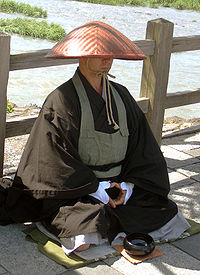
Fudoshin is a state of equanimity or imperturbability (literally and metaphorically, "immovable
heart"or "unmoving heart"– a philosophical/mental dimension to a (usually Japanese) martial art which contributes to
the effectiveness of the advanced practitioner.
Martial Arts Maxims
1. Shu Ha Ri.
Shu. Observe the old without straying. The student directly studies the teacher's way.
Ha. Break strict observation and adapt different teachings. This is the stage of experimentation
and research.
Ri. Leave, advancing beyond both former stages. The student goes beyond the teachings to develop a style
within a style. This does not mean a new style is created; rather, that the student now places a new emphasis on his favorite
teachings. Not new; however, view and perhaps taught from a new perspective. This new/old perspective is an enlightenment
to the student.
2. Shin Sho Ken Choku.
Correct your heart in order to correct your sword.
3. Shin Ken Hyaku Ja Futsu.
Eliminate all evils through god's sword
or
With a real
(god's) sword, dispel self-evil.
Severe training brings self-attainment. This is Nakamura Taizaburo sensei's favorite
maxim. Literally it means 100 trainings, self-attainment. After severe training 100 times (100 is equivalent to meaning infinity)
you will receive attainment (understanding or enlightenment) by yourself.
5. Ryu Gan Go Do.
Flowing perspiration is the road to enlightenment. This is Onozaki Mitsuhiro
sensei's favorite maxim. This maxim has the same meaning as Hyaku Ren Ji Toku.
6. Ken Gon.
Sword
Soul. The soul of the sword manifests in your spirit. This is Suzuki Kunio sensei's favorite maxim.
7. Nippon
To Hito ni Kirarezu Hito Kirazu Jiko no Renma ni Shugyo no Michi.
The Japanese sword: not being killed by
others, not killing others; cultivating self via severe training. This is the Way of discipline. This is a Japanese poem by
Nakamura sensei.
8. Shin Gi Tai.
Spirit, Technique, Body. The three inseparable entities which
create the whole martial artists. If one element is de-emphasized in the least, the true martial artist becomes unbalanced.
9. Shin Gyo.
Action of the heart. Do things through the heart.
10. Hei Jo
Shin.
Normal state of mind. Maintain one's state of mind or composure without being affected by the environment.
Unaffected spirit.
11. Hei Jo Shin no Michi.
The Way of the composed mind.
12. Rei Gi Shin Chi Jin.
Courtesy, Obligation, Belief, Knowledge,
Virtue. These are called the Go Jo, or Five Ordinaries (Confucian) and are considered the beginning of budo (budo no hajime).
Without these five Confucian ethics the martial arts devolve into brutish brawling.
13. Fudo Shin.
Immovable
Spirit. Unaffected spirit (heijo shin). Fudo Myo-o is one of the protector gods within the Buddhist panoply, so the translation
could also be to have the spirit of Fudo Myo-o. Fudo Myo-o waits at the gate of hell to assist those who have strayed from
the path -- he assists them with the rope of truth and his sword cuts through delusion to help those in need of enlightenment.
14. Sen Shin.
Clean the mind/spirit. In Japanese shin means heart; however, heart is translated
as mind or spirit and should not be confused with the physiological heart (shinzo). Heart/mind/mentality should not be thought
of three separate ideas, but one all-encompassing thought.
15. Katsu Jin Ken Satsu Jin Ken.
The
life-giving sword; the life-taking sword. This is the sword that is used righteously to vanquish evil, either physically or
spiritually. Do not use the sword improperly, with evil intent. In Japanese satsujin actually means murder. Wield the life-giving
sword, not the murdering sword.
The Symbols used Fudo-Myo-o Shugendo are the Dragon and the Koi Carp.
The dragon represented two
of the ancient elements, Earth and Water, endowing the creature with powers of illusion and strength. A Yang symbol, the Taoists
saw the dragon as a personification of the Tao itself--"the Dragon reveals himself only to vanish." Shaolin Buddhists saw
him as a vision of enlightened truth, to be felt, but never to be held. Certain very old men were called dragons, these being
well versed in the life-supporting skills of herbal medicine, agriculture, and kung fu. In early China, these skills were
surely a matter of life or death, and those so educated were held in high esteem.
The Dragon symbolises Courage, Strength,
Raw power and force, Wisdom and Reason, Protectors of sacred items.
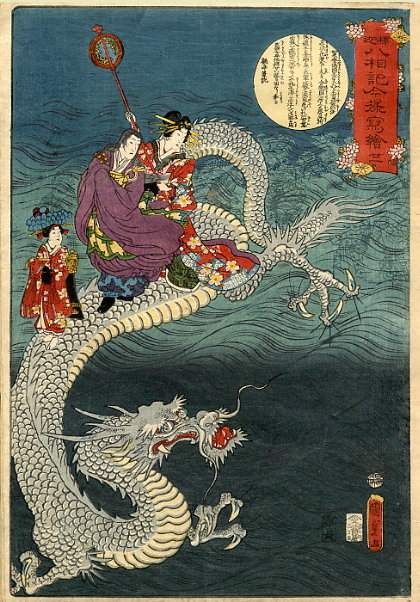
The Koi fish is pure perseverance - Koi swimming upstream can be interpreted as showing perseverance because
of the fact that the Koi does not "go with the flow". This can show a person how to be strong in the face of adversity and
develop strength of character or purpose. The Carp can also represents wisdom, knowledge, longevity, and loyalty.
Strength
in time of adversity - Koi fish also symbolizes persistence and the willingness to go on even though it is being swept away.
It also symbolizes surpassing obstacles. The Koi fish swimming upriver can show how to overcome various obstacles and how
come win victory over outside influences.
At the centre of all things is Fudo-Myo-o who shows us that our body, mind and spirit are immovable. Our Chi is one with
nature.
Posted by yhoni1967 at 1:10 PM EDT
Updated: Wednesday, 8 April 2009 2:35 PM EDT
Newer | Latest | Older

